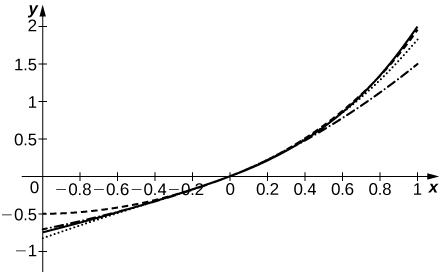-
Home
- Calculus volume 2
- Power series
- Properties of power series
Evaluate
as
where
so
Got questions? Get instant answers now!
In the following exercises, given that
use term-by-term differentiation or integration to find power series for each function centered at the given point.
at
Got questions? Get instant answers now!
where
Term-by-term integration gives
Got questions? Get instant answers now!
[T] Evaluate the power series expansion
at
to show that
is the sum of the alternating harmonic series. Use the alternating series test to determine how many terms of the sum are needed to estimate
accurate to within 0.001, and find such an approximation.
Got questions? Get instant answers now!
[T] Subtract the infinite series of
from
to get a power series for
Evaluate at
What is the smallest
N such that the
N th partial sum of this series approximates
with an error less than 0.001?
We have
so
Thus,
When
we obtain
We have
while
and
therefore,
Got questions? Get instant answers now!
In the following exercises, using a substitution if indicated, express each series in terms of elementary functions and find the radius of convergence of the sum.
using
If
then
If
then
when
So the series converges for all
Got questions? Get instant answers now!
Show that if
is a sum of even powers, that is,
if
n is odd, then
is a sum of odd powers, while if
f is a sum of odd powers, then
F is a sum of even powers.
Got questions? Get instant answers now!
[T] Suppose that the coefficients
a
n of the series
are defined by the recurrence relation
For
and
compute and plot the sums
for
on

The solid curve is
S
5 . The dashed curve is
S
2 , dotted is
S
3 , and dash-dotted is
S
4
Got questions? Get instant answers now!
[T] Suppose that the coefficients
a
n of the series
are defined by the recurrence relation
For
and
compute and plot the sums
for
on
Got questions? Get instant answers now!
[T] Given the power series expansion
determine how many terms
N of the sum evaluated at
are needed to approximate
accurate to within 1/1000. Evaluate the corresponding partial sum
When
Since
one has
whereas
therefore,
Got questions? Get instant answers now!
[T] Given the power series expansion
use the alternating series test to determine how many terms
N of the sum evaluated at
are needed to approximate
accurate to within 1/1000. Evaluate the corresponding partial sum
Got questions? Get instant answers now!
[T] Recall that
Assuming an exact value of
estimate
by evaluating partial sums
of the power series expansion
at
What is the smallest number
N such that
approximates
π accurately to within 0.001? How many terms are needed for accuracy to within 0.00001?
One has
and
so
is the smallest partial sum with accuracy to within 0.001. Also,
while
so
is the smallest
N to give accuracy to within 0.00001.
Got questions? Get instant answers now!
Source:
OpenStax, Calculus volume 2. OpenStax CNX. Feb 05, 2016 Download for free at http://cnx.org/content/col11965/1.2
Google Play and the Google Play logo are trademarks of Google Inc.

